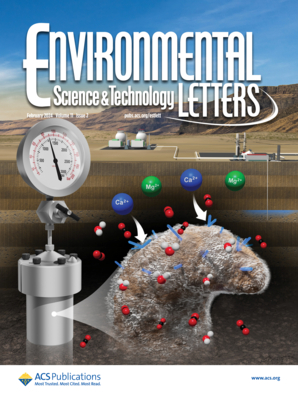Clinical, echocardiographic, and pathologic characteristics of patients with pathology-proven nonbacterial thrombotic endocarditis
IF 8.9
2区 环境科学与生态学
Q1 ENGINEERING, ENVIRONMENTAL
Environmental Science & Technology Letters Environ.
Pub Date : 2024-10-28
DOI:10.1093/eurheartj/ehae666.3040
引用次数: 0
Abstract
Background Non-bacterial thrombotic endocarditis (NBTE) is a non-infectious condition characterized by thrombotic and/or inflammatory depositions involving the cardiac valves. It is a challenging diagnosis of exclusion. Purpose This study aimed to better characterize patients with pathologically proven NBTE and assess its clinical, echocardiographic characteristics and prognostic implications. Methods We retrospectively identified patients with pathology-proven NBTE at a single center. Patients with positive preoperative blood cultures, a history of active or treated infective endocarditis, or identification of valvular organisms by special stains were excluded from the study. Patients with pathology reports of valve perforation or chordal rupture were also excluded because of the high likelihood of an infectious etiology for these lesions. Results A total of 53 patients with NBTE (median age 57 years; 61% females) were identified. In this cohort, 22% had a history of malignancy, 30% had connective tissue disease, 32% had coronary artery disease, and 11% prior history of NBTE. Neurological events accounted for 18 (34%) of the presenting symptoms (TIA n=17, CVA n=9), while new valvular dysfunction in 7 (13%) and fever in 8 (15%) of patients. Five patients (9%) had NBTE involving more than one valve. NBTE involved the mitral valve in 64%, aortic valve in 38% prosthetic/mechanical valve in 11%, and tricuspid valve in 5%. NBTE was identified at the time of autopsy in 34% of patients. NBTE recurred in 3 patients during follow-up. Excluding patients diagnosed at the time of autopsy, 9% of patients died within 1 year of NBTE diagnosis. Conclusion NBTE was diagnosed pathologically in the presence of hyper-inflammatory states due to critical illness or immunological diseases. It was predominantly on the left side of the heart and was associated with embolic phenomena, either clinically or on imaging. Patients diagnosed with antemortem with NBTE have a high mortality in the first year (9%).经病理学证实的非细菌性血栓性心内膜炎患者的临床、超声心动图和病理学特征
背景 非细菌性血栓性心内膜炎(NBTE)是一种非感染性疾病,其特征是累及心脏瓣膜的血栓和/或炎症沉积。它是一种具有挑战性的排除性诊断。目的 本研究旨在更好地描述病理证实的 NBTE 患者的特征,并评估其临床、超声心动图特征和预后影响。方法 我们在一个中心回顾性地确定了经病理学证实的 NBTE 患者。术前血液培养阳性、有活动性或治疗过的感染性心内膜炎病史或通过特殊染色鉴定出瓣膜生物体的患者不在研究范围内。病理报告为瓣膜穿孔或脊索破裂的患者也被排除在外,因为这些病变极有可能是感染性病因所致。结果 共发现 53 名 NBTE 患者(中位年龄 57 岁;61% 为女性)。其中 22% 有恶性肿瘤病史,30% 有结缔组织疾病,32% 有冠状动脉疾病,11% 有 NBTE 病史。18例(34%)患者出现神经系统症状(TIA n=17,CVA n=9),7例(13%)患者出现新的瓣膜功能障碍,8例(15%)患者出现发热。五名患者(9%)的 NBTE 涉及一个以上的瓣膜。64% 的 NBTE 涉及二尖瓣,38% 涉及主动脉瓣,11% 涉及人工/机械瓣,5% 涉及三尖瓣。34%的患者在尸检时发现了 NBTE。3 名患者在随访期间复发了 NBTE。除去尸检时确诊的患者,9%的患者在确诊 NBTE 后 1 年内死亡。结论 NBTE 是在危重病或免疫性疾病导致的高炎症状态下病理诊断出来的。它主要发生在心脏左侧,并与临床或影像学上的栓塞现象有关。死前确诊为 NBTE 的患者第一年的死亡率很高(9%)。
本文章由计算机程序翻译,如有差异,请以英文原文为准。
求助全文
约1分钟内获得全文
求助全文
来源期刊

Environmental Science & Technology Letters Environ.
ENGINEERING, ENVIRONMENTALENVIRONMENTAL SC-ENVIRONMENTAL SCIENCES
CiteScore
17.90
自引率
3.70%
发文量
163
期刊介绍:
Environmental Science & Technology Letters serves as an international forum for brief communications on experimental or theoretical results of exceptional timeliness in all aspects of environmental science, both pure and applied. Published as soon as accepted, these communications are summarized in monthly issues. Additionally, the journal features short reviews on emerging topics in environmental science and technology.
 求助内容:
求助内容: 应助结果提醒方式:
应助结果提醒方式:


